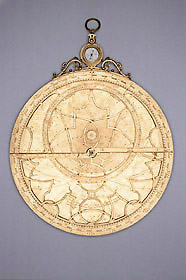
 |
| Catalogue |
 |
 Astrolabe The limb is divided into 24 hours to the half and quarter hour by alternate shading, numbered I to XII twice. The limb is further divided into 360? in four quadrants with 90? at the zenith, subdivided to 10?, to 5? and to 1? by alternate shading, numbered by 10?. Suspension is by means of a ring, shackle and throne. The ring is filleted, as is the shackle. The throne, which is elaborately decorated, has a compass on it, with magnetic deviation and the four cardinal points marked. On the back of the throne is a rotating volvelle fixed on a plate graduated 1 to 12 twice. The volvelle is graduated 1 to 24 and is used for conversion of hours. The inner side of the mater is engraved with a quadratum nauticum with 32 directions named inside the wind rose. The four main winds are engraved 'NOTVS', 'ZEPHIRVS', 'SEPTENTRIO' and 'SVBSOLAVS'. On a circle outside the wind rose are engraved the Italian names of the eight main winds. The square is divided to 10?, to 5? and to 1?, numbered by 10?. Outside the square are the indications 'Latitudo maior aut borealior', 'Latitudo minor uel Australior', 'Longitudo maior seu Orientalior', 'Longitudo minor seu Occidentalior' and the names of the cardinal points in Latin. On a circle towards the limb are engraved the names of 28 directions and the four cardinal points in Dutch. The very edge of the plate is decorated with thin concentric lines. The rete, of typical Flemish pattern, has 43 flambent star pointers, all named. The ecliptic circle is wrongly divided (as in all Habermel astrolabes) in 360?, to 10?, to 5?, to 1?, numbered by 10? from [0?] to 30?. The zodiac signs are named and their symbols are engraved. There are no east-west or meridian bands. The only plate is engraved on each side with an east-west line indicated 'Horizon rectus' and a meridian line, as well as tropic and equator lines indicated 'Tropicus Capricorni', 'Tropicus Cancri', and 'AEquinoctialis'. The twilight line is dotted and indicated 'Linea Crepusculina'. Three cardinal points (except for north) are indicated in Latin. The astrological houses are numbered I to 12 and indicated by 'Domus' next to the first house, and the unequal hour lines are numbered I to XII and indicated by 'horae inequales' next to the first hour. The almucantars are engraved every 1? and numbered by 10?, and the azimuth lines are engraved every 2? and numbered by 10?. The first almucantar is marked 'Horizon obliquus'. One side of the plate is engraved 'Pro eleuatione poli 50 qualis est Pragae, Olmutn, Nissae, Cracouiae, Item 49 ut noribergae, Crumno uiae, Trebonjs, Item 51 ut Bratislauiae, Dresdae, Antuerpiae, Coloniae.'. The other side is engraved 'Pro eleuatione poli 48 qualis est Viennae, Linzae, Ratisbonae, Monachj, Augustae, Vlmae, Salisburgj, Argentinae, Basileae, Parisjs'. The back of the mater is engraved with a scale of degrees in four quadrants of 90? with 90? at the zenith, divided to 10?, to 5? and to 1?, numbered by 10. Further to the centre is a zodiac scale sharing the division with the other scale, with a figure engraved for each sign and degrees grouped by 30?. Further to the centre is a calendar scale divided to 10, 5 and to the day, with the months named in Latin and the 10th, 20th and last day numbered. The first point of Aries corresponds to 20.5 March. On the calendar scale are marked the main feasts of the Church. Next to the centre of the plate is, on the upper half, a diagram for converting equal (marked 'HORAE AEQUALES' and 1 to 12), and unequal hours (marked 'Horae inequales' and numbered I to XII). The hours are also indicated 'Horae ante meridiem' and 'Horae post meridiem'. On the bottom half is a double shadow square, marked 'VMBRA VERSA' and 'VMBRA RECTA' numbered from [0] to 12 by 3 and divided [0] to 60 to 5 and to 1, numbered by 10. Inside the shadow square is a cartouche with a table of ruling planets, entitled 'TABVLA PLANETARIVM DIEI'. Between the shadow square and the calendar scale is an arabesque decoration typical of Habermel with his signature 'Erasmus Habermel fe:'. The counterchanged alidade has two folding sights, one of which has three holes and the other a sighting pin, and is graduated with two equal scales 1 to 12, divided to 1, subdivided to 1/4 and numbered by 1. The arms of the alidade are indicated 'Horae ab Ortu' and 'Horae ab Occasu'. The ends of the alidade are decorated in a Gothic way. The rule is counterchanged and has geometrical decoration on one arm, and on the other a scale of latitudes, divided [0] to 80 and [0] to 231/2 to 10, to 5 and to 1, numbered by 10, and indicated 'Declinatio Septentrionalis' and 'Declinatio Meri:'. The screw is decorated with concentric circles, and the nut, in the form of an eight-pointed star, is probably a later replacement. See H. Michel, Trait? de l'Astrolabe (Paris, 1947). Ilaria Meliconi |



